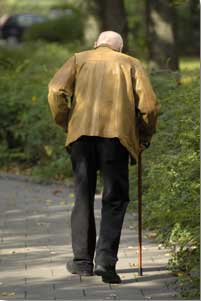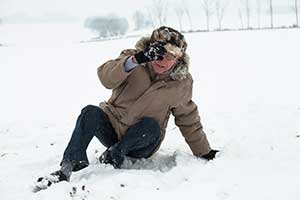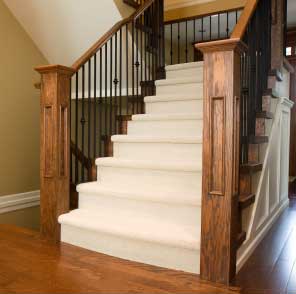
- Falling is not a normal part of aging.
- Falling is a very common and very serious health concern in older adults.
- Falls are caused by many factors. The more risk factors a person has, the greater the chance of falling.
- There are a number of simple practical steps that you can do to reduce the chance of falling and maintain independent living.
- Report all falls to your family member's doctor or healthcare provider.

- Falling is a very common and very serious health concern for older adults.
- While falls are not a normal part of getting older, the numbers of people who fall are high. Each year, for people over the age of 65 who live in the community, 35% will fall. This increases to 50% for those over the age of 80. The rates for those living in nursing homes are even higher.
- Falls are the leading cause of serious injury in older adults.
- Recovery from falls can be lengthy and consequences can be serious.
- Injuries can range from bruises to a fractured hip.
- Even without an injury, a fall can cause the older person to be fearful of falling again. This can lead to inactivity, isolation, depression, and additional health problems.
- A fall may result in a person being unable to get up. This is called a "long lie," which can cause pneumonia, pressure sores, blood clots, and general weakness. See instructions below for learning how to get up.
- As a caregiver, you need to know the risk factors for falls, as well as the simple things that can prevent a fall. You also need to know what to do in the event of a fall and when to seek medical attention for your family member.
What is a Fall?
A fall occurs when a person slips, trips, or falls suddenly onto the ground or floor. The fall may or may not cause an injury.
- A fall can range from a minor loss of balance to a very forceful and serious incident.
- A fall can happen at home or in the community. It can be due to
- environmental factors, such as cluttered areas or uneven surfaces, or
- individual factors, such as weakness, balance difficulties, medications, or medical problems.
Risk Factors

- People fall for many reasons. These are called risk factors.
- Knowing a person’s risk factors is important, so you can take action to reduce their chance of falling.
- The following factors increase the risk of falling:
- Weak leg muscles
- Problems with walking and balance
- Taking medications to help relax, sleep, or improve mood
- Poor vision and untreated hearing loss
- Lightheadedness or dizziness
- Depression
- Memory problems
- Having fallen before
- Things in the environment either indoors or outdoors
- Although a fall may happen to a person with none of these risk factors, the risk of falling increases as the number of factors increases.
- Certain medical conditions, such as a stroke, Parkinson's disease, arthritis, diabetes, or dementia, increase the risk of falling.
- Behaviours like being hasty, hurrying, and trying to do too many things at once can increase the risk as well. Simply being afraid of falling can increase the risk.
- Rushing to the bathroom, getting up at night to the bathroom and going often during the day or night are associated with an increased risk of falling.
- Household hazards like slippery floors, loose scatter rugs, steep stairways, loose fitting slippers, and clutter can cause falls. In outdoor areas, poor lighting, icy sidewalks, and obstructed walkways can cause falls.
Prevent a Fall Before it Happens
The following can help your family member reduce the risk of falling:
- Have a doctor or pharmacist review medications every year
- Have their eyes checked each year
- Be physically active every day
- Have their blood pressure checked including postural blood pressure postural blood pressure
- Look around their home to identify hazards and make simple changes. (The National Center for Injury Prevention and Control provides a Home Fall Prevention Checklist.)
If a Fall Occurs
 You can teach your family member what to do if a fall occurs. Here
are some simple instructions. Further instructions with diagrams are available on page 18: “Take Action: Prevent a fall before it happens”
You can teach your family member what to do if a fall occurs. Here
are some simple instructions. Further instructions with diagrams are available on page 18: “Take Action: Prevent a fall before it happens”
- Stay calm.
- If you are not hurt and can get up, follow these steps:
- Roll onto your side.
- Move onto your hands and knees.
- Crawl to the nearest piece of sturdy furniture, e.g. bed, chair, coffee table, toilet.
- Place your hands on the seat.
- Place one foot flat on the floor.
- Push up with your arms and legs and stand up.
- Turn yourself gently and sit down.
- Rest before trying to move.
- Let your healthcare provider know after you have a fall.
If You Cannot Get Up
If you cannot get up, follow these steps:
- Stay calm.
- Get help by shouting, banging, blowing a whistle, or pressing your emergency call button. Keeping a cordless phone or cell phone with you will make it easy to reach.
- Get comfortable.
- Keep warm. Cover yourself with clothing or whatever is handy, such as a tablecloth or rug.
- Keep moving your joints to prevent pressure areas, blood clots, and stiffness.
Helping Someone to Get Up
 Know how to safely help someone to get up. You will guide them and not
be picking them up. Further instructions with diagrams, are available on page 19 of “Take Action: Prevent a fall before it happens”:
Know how to safely help someone to get up. You will guide them and not
be picking them up. Further instructions with diagrams, are available on page 19 of “Take Action: Prevent a fall before it happens”:
- Do not try to get the person up right away.
- Often people are upset. Help them take deep, slow breaths to calm down.
- Check for injuries.
- If they are injured, call an ambulance. Keep them warm while you wait.
- If they are not seriously injured, and think they can get up, get two sturdy chairs and place one near their head and one near their feet.
- Guide the person to roll onto their side.
- Help the person to kneel.
- Place one chair in front of them.
- Have the person place their hands on the chair. Then place one foot flat on the floor.
- Push up on the seat with their arms and stand.
- Place the second chair behind them and have them sit on it. Do not lift them into the chair.
- Call the person's healthcare provider to let them know about the fall.
NOTE: Let the person rest as often as they need to. If at any time you get stuck, call an ambulance.
When to Seek Help
Falls are not a normal part of getting older, so if your family member has a fall, it is important for them to see their doctor or healthcare provider even if they are not hurt. It is important for the doctor or healthcare provider to assess for the risk
factors that contributed to the fall, so they can be addressed. Even if the fall can be explained, seeking medical attention is important. An example might be tripping over a mat in the hallway that has been there for 10 years when no previous trip
has happened.
You should accompany your family member to the emergency room if they have a major fall OR if any of the following occurs after a fall:
- They have pain in the hip or groin
- They have pain anywhere when standing or trying to walk
- They are limping or are unsteady when walking
- They have serious back pain
- They have pain or swelling, or if a bone has an unusual shape. This could be on arms or legs.
- They complain of dizziness, memory loss, blurred vision, (signs of head injury) even if it's several hours or days later.
- They have cuts with serious bleeding.
Always let the emergency room staff know that the injury resulted from a fall.
Not all falls can be prevented, so it is important to take steps to prevent a possible injury.
- Use hip protectors as they have been proven effective in decreasing the chance of hip fractures.
- Take enough calcium and Vitamin D for strong bones.
- Stay physically active for strength and balance.
While the content of each Caregiver College Topic may be linked to a variety of other Topic areas, the following has been identified as a Key Linkage, which you may be interested in also reviewing:
Alberta Health Services
- Health Link Alberta can provide a list of falls prevention services in and around Edmonton.
- Alberta Health Services Falls Prevention
Finding Balance Alberta
This website provides information specific to Alberta with resources for the public
and for healthcare providers. It has key messages that
everyone should know and
seasonal tips to reduce your risk of falls.
Canadian information on bone health can be located at this website.
Recommendations for the amounts of calcium and Vitamin D are listed as well as
recipes to include calcium. Not sure if you are getting enough? Try their calcium
calculator.
- This resource provides direct links to fall prevention tips and other safety resources for seniors.